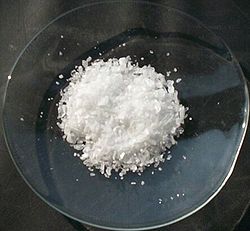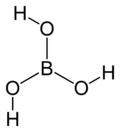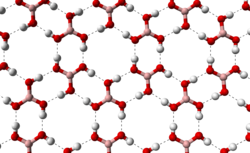Boric acid
Boric acid is an acid of boron. Its salts are called borates. Boric acid is used as a disinfectant. It can also be used as a preservative, it has the E number 284. Boric acid is a by-product of the production of certain forms of glass, porcelain and vitreous enamel. It is also used as a Flame retardant. Dissolved in water, it acts as a neutron absorber in nuclear power plants.
| Boric acid | |
|---|---|

| |
| IUPAC name | Boric acid Trihydrooxidoboron |
| Other names | Orthoboric acid, Boracic acid, Sassolite, Optibor, Borofax, Trihydroxyborane |
| Identifiers | |
| CAS number | |
| PubChem | |
| EC number | 233-139-2 |
| KEGG | D01089 |
| ChEBI | CHEBI:33118 |
| SMILES | OB(O)O |
| Properties | |
| Molecular formula | H3BO3 |
| Molar mass | 61.82 g mol-1 |
| Appearance | White crystalline solid |
| Density | 1.435 g/cm3 |
| Melting point |
170.9 °C, 444 K, 340 °F |
| Boiling point | |
| Solubility in water | 2.52 g/100 mL (0 °C) 4.72 g/100 mL (20 °C) 5.7 g/100 mL (25 °C) 19.10 g/100 mL (80 °C) 27.53 g/100 mL (100 °C) |
| Solubility in other solvents | Soluble in lower alcohols moderately soluble in pyridine very slightly soluble in acetone |
| Acidity (pKa) | 9.24 (see text) |
| Structure | |
| Molecular shape | Trigonal planar |
| Dipole moment | Zero |
| Hazards | |
| EU classification | Harmful (Xn) Repr. Cat. 2 |
| NFPA 704 |
|
| R-phrases | R60 R61 |
| S-phrases | S53 S45 |
| Flash point | Non-flammable. |
| Related compounds | |
| Related compounds | Boron trioxide Borax |
| Except where noted otherwise, data are given for materials in their standard state (at 25 °C, 100 kPa) | |
Boric acid is toxic. Damage is done from absorbing or ingesting about 50 mg, per kg of body weight.
Boric acid is one of the chemicals on the REACH list of the European Union. In 2010, the European Chemicals Agency listed it as a Substance of very high concern. Boric acid causes birth defects; it is a teratogen. This is also true for mixtures that contain boric acid in a concentration of at least 5.5%.






